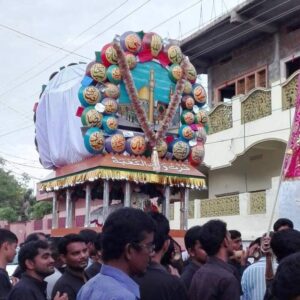Nakhl Gardani (Muharram Ritual of Iran)
You are Here: Tweet, Like, Share, Comment, Subscribe…be the Voice of Free Press!
By Shahana Naqvi, Copy Edited By Adam Rizvi, The India Observer, TIO:
Introduction:
Rituals are considered ,the practice of reflection of the beliefs of communities. They are series of actions that are performed in a rhythmic and orderly manner which imposes discipline and self control in the individual.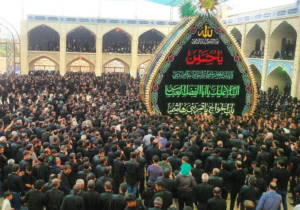
Tragedy of Karbala is an event that is commemorated every year with religious fervour in Iran, remembering the unjust massacre of Imam Hussain on the desert plains of Karbala (Iraq) in 680AD.
Nakhl Gardani is one of main Shia ritual observed during the month of Muharram in Iran and dates back to the Safavid period (1501-1736).
Nakhl
Nakhl means Palm tree in Persian, Palm tree was called ,”tree of life”, in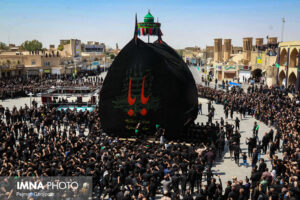 ancient Persia for the sake of resistance, beauty and blessing.
ancient Persia for the sake of resistance, beauty and blessing.
Nakhl is a wooden structure used as a symbolic representation of Imam Hussain’s coffin (casket).
History
Nakhl is rooted in ancient Persian history and pre- dates Islam, where a purified handsome prince Siavash (Ferdousi ‘s Shahanameh ) is killed on false accusation.
According to some historians Imam Hussain’s body was abandoned, lying unburied in the desert plains of Karbala for three days and was carried to the burial place on the branches of a Palm tree, thus symbolic coffin came to be known as Nakhl.
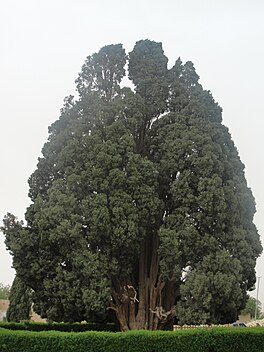
Iran’s Museum of Mourning Tools
Shape and Size
Due to it’s survival in the tough desert condition, the cypress tree has been considered as a, “Symbol of Resistance ”, by ancient Persians and the shape of Nakhl takes inspiration from it’s Pear shape.
Nakhl is a wooden checkered structure shaped like a Cypress tree with a scaffolded shape like a tree leaf.
Size
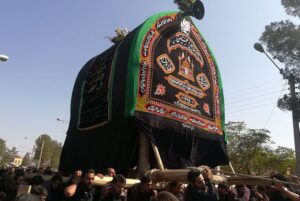 Nakhls are made of various sizes from smallest ones that two people can carry to enormous structures that requires 100 plus people to carry it’s weight, which is over a tonne like the Amir Chakhmaq Nakhl in Yazd.
Nakhls are made of various sizes from smallest ones that two people can carry to enormous structures that requires 100 plus people to carry it’s weight, which is over a tonne like the Amir Chakhmaq Nakhl in Yazd.
Power of faith and resilience
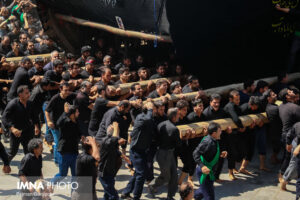 The weight of the wooden Nakhl after decorations increases and those who intend to carry Nakhl usually tie a piece of cloth or a small pillow on their shoulders for long distance .
The weight of the wooden Nakhl after decorations increases and those who intend to carry Nakhl usually tie a piece of cloth or a small pillow on their shoulders for long distance .
Types of Wood
Nakhls are made entirely of wood and to join pieces of wood nails, pegs and iron fasteners are used ,originally no glue was used for building Nakhls.
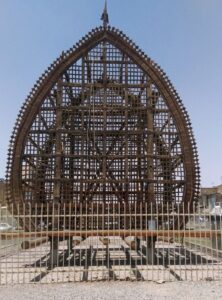 They made into checkered squares and grids.
They made into checkered squares and grids.
Generally made of dense hardened wood Nakhls are constructed usually of Black Poplar, Oak, Walnut and even Russian wood.
The structure of Nakhl consist of a wood frame with a floor on which there are 8 to 20 wooden beams and timber ,4 to 12 long wooden columns forms the main body of Nakhl and is made by connecting several pieces of wood .
Decoration
Predominant colour of the fabric cover used to cover the skeleton of the Nakhl is Black which is symbolic of Mourning and Green which represents Imam Hussain’s clothes.
Nakhl is dressed from top to bottom
It is decorated with colourful silk shawls, precious fabrics like termeh, mirrors, flowers and green branches, ornaments and even light bulbs, all of them have symbolic meaning .
War tools like, swords, daggers, shields and helmets also form part of the ensemble along with with decorational items like candles, lanterns and flag all add to the beauty of the Nakhl.
Decoding the Nakhl
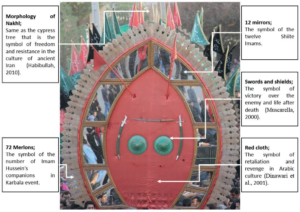
Babay-e-Nakhl
Also known as Nakhl Band is the person who decorates the Nakhl with symbolic objects which are sometimes donated by the people.
Babay-e-Nakhl along with his assistants decorate the Nakhl of their neighbourhood with the intention of Barakatkhani or blessings.
Usually the time spent on decorating the Nakhl depends upon the size and decorative objects on the Nakhl.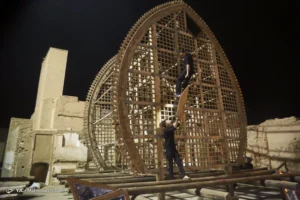
Babay -e -Nakhl is usually a person from a noble family of a neighbourhood, and this responsibility is given to a person from Sadat (descendants of Prophet Muhammed’s family), who carries it from one generation to another .
Glossary of tasks
In the ritual of Nakhl gardani different tasks are assigned to people who carry their individual duties so that the ceremony runs smooth without any chaos in the public like….
Nakhl Keshan, carriers of Nakhl, guided by special etiquette, they are guided by the Nakhl guide
Nakhl Guide, guide of the group that carries the Nakhl andsits on top and shows them the route and co-ordinates the movement of the Nakhl.
They are usually an experienced old man from a noble family or Sayyid.
Nakhl Gardani
Nakhl Gardani is an ancient mourning ritual, commemorating the death of Husain ibn Ali, grandson of Prophet Muhammed and third Shia Imam, Imam Hussain ibn Ali.
It is a major Shia religious ritual practiced in Iran and carried out on the day of Ashura or tenth Muharram.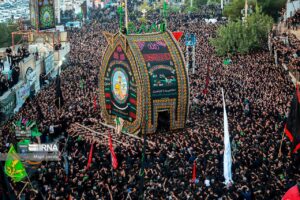
Nakhl Gardani is the act of carrying Nakhl from one place to another. The ritual of Nakhl Gardani is done at a certain time of the day, depending upon the custom of each region but most importantly at noon time on the day of Ashura.
Nakhl Gardani is literally carrying and turning the Nakhl.
The ritual
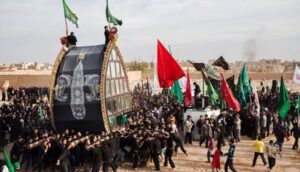 First the mourners assemble at the square and recite certain verses of the mourning poems in memory of the martyrs of Karbala, together while striking their chests which is called Sinezani.
First the mourners assemble at the square and recite certain verses of the mourning poems in memory of the martyrs of Karbala, together while striking their chests which is called Sinezani.
Then some young and strong men or khadem go under the Nakhl guided by an elderly and start lifting the Nakhl on their shoulders, carrying it on a pre -set route, through alleys and squares of the main town and cities .
 Usually an old Sayyid (decendant of Prophet Muhammad )stands on top of a Nakhl and chants Ya Hussain and guides the passing procession of mourners carrying the huge wooden bier, so that no one is left under.
Usually an old Sayyid (decendant of Prophet Muhammad )stands on top of a Nakhl and chants Ya Hussain and guides the passing procession of mourners carrying the huge wooden bier, so that no one is left under.
Men dominated ceremony
Nakhl Gardani is a Masculine Ritual, since Islam prohibits women to carry coffin although they do participate in other functions and ceremonies related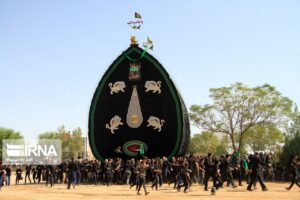 to Nakhl Gardani.
to Nakhl Gardani.
Nakhl Gardani is carried in unison by the mourners who circle the square several times usually three times ,at the same time people cry out mourning chants before placing the Nakhl back to it’s place in the Takiya or Hossaniya.
Musicians with mourning beats accompany these processions with drums and cymbals.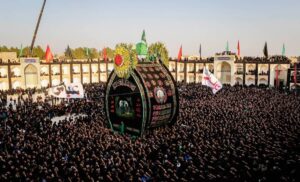
Many other rituals associated with Nakhl gardani include Gelmali (rubbing mud over bodies) and Bilzani (shovelling) in Khosf village , also take place which are symbolic but don’t match the events of Ashura.
Yazd
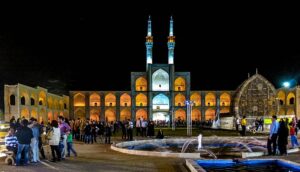
Yazd city ,the cradle of Zoroastrianism ,situated in the Central Desert region of Iran has been designated a place in UNESCO’s World Heritage List. It is famous world over for it’s unique desert architecture.
Yazd province has a population of one million and is home to thousand of Mosques and Hossainya’s that it is also known as Iran and the world’s Hossainya.
Largest Nakhl
Historically the city of Yazd has two very large Nakhl’s one at Amir Chakhmaq Square and the other at Shaheed Behest Square.
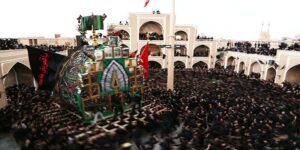
Yazd is home to biggest and oldest Nakhl in the world with 8.5 meters this ancient wooden wonder is around 450 years old.
This huge Nakhl was not used because of age, but after restoration the Nakhl Gardani ritual was finally resumed after over 50 years in 2017.
After Ashura
After the day of Ashura and Arbaeen , the Nakhl is kept in a corner of Hosseniya, Mosque or a place where the mourning ceremony takes place .They are kept dressed in Black cloth till the ceremonies of Ashura and Arbaeen are over.
Nakhl in India
India, the land of diversity, has absorbed an amalgamation of different rituals and cultural beliefs from various communities, and the rituals associated with the observance of Muharram are no different.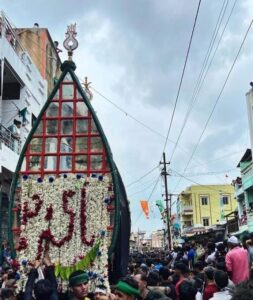
Taking out Nakhl during Muharram is a tradition that has been observed throughout various regions of the country .
It is taken in Khambat (Cambay ) in Gujarat, probably because the Nawab of Khambat traces his lineage from Persia, hence his family brought with themselves a bit of their culture too.
Mr. Ali Khan has been kind enough to share pictures of different types of Nakhl used in Muharram ceremonies in India. He has also shed light on the practices that display a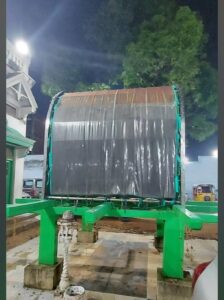 mosaic of cultural exchange, transcending borders and countries, and bringing people together to mourn the martyrdom of the grandson of the Prophet of Islam, the Champion of Truth and Justice, Imam Hussain (A.S.). Along with his small band of 72 followers, he was mercilessly slaughtered without food or water on the desert plains of Karbala, 14 centuries ago.
mosaic of cultural exchange, transcending borders and countries, and bringing people together to mourn the martyrdom of the grandson of the Prophet of Islam, the Champion of Truth and Justice, Imam Hussain (A.S.). Along with his small band of 72 followers, he was mercilessly slaughtered without food or water on the desert plains of Karbala, 14 centuries ago.
Also Read more from this Author: “From Legacy to Leadership: A Candid Conversation with Congress Veteran Imran Kidwai”
Curated and Compiled by Humra Kidwai
Articles written by contributors have different viewpoints. The views expressed in the articles are the author’s own and not necessarily supported by TIO, The India Observer its affiliates, staff, or the management. Our Articles can be reproduced, with the following conditions, (1) No alteration to the content, (2) Visible, and full credit is given to the Author & Editor. (3) Citing, The India Observer, TIO. In the case of online or electronic media, a link to the original article must be given. Rules are strictly enforced. Any questions, email the Editor at: Mediaiss@gmail.com Or TheIndiaObserver@gmail.com

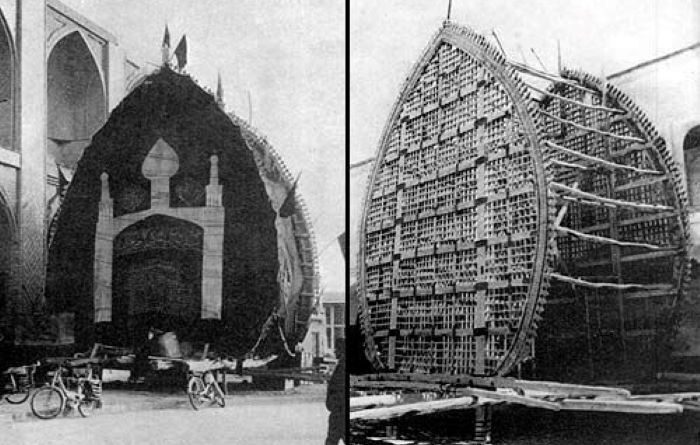
 Decorations on a Nakhl starts from the first of Muharram, on 9th Muharram (Tasua), Nakhl is covered in green colour and on 10 Muharram(Ashura), it is dressed in black coloured cloth representing mourning.
Decorations on a Nakhl starts from the first of Muharram, on 9th Muharram (Tasua), Nakhl is covered in green colour and on 10 Muharram(Ashura), it is dressed in black coloured cloth representing mourning.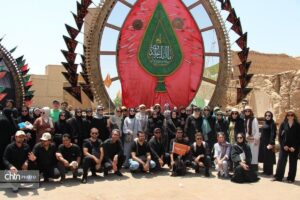 travelogues. Muharram mourning rituals in the central desert region of Iran, especially in Yazd Province, have drawn an influx of tourists from across Iran, as well as foreign visitors and delegates who come to witness this ancient and unique religious ceremony.
travelogues. Muharram mourning rituals in the central desert region of Iran, especially in Yazd Province, have drawn an influx of tourists from across Iran, as well as foreign visitors and delegates who come to witness this ancient and unique religious ceremony.